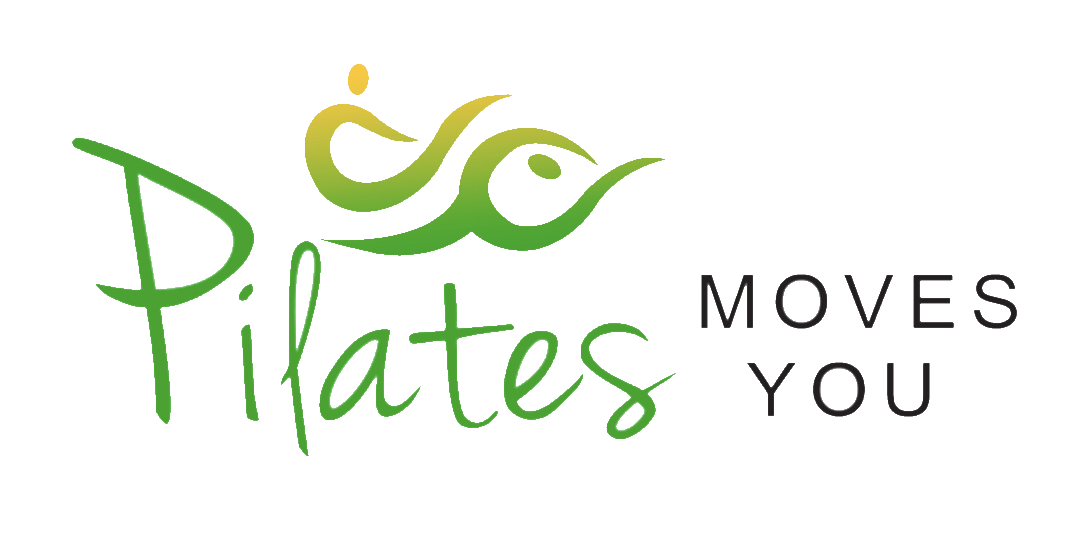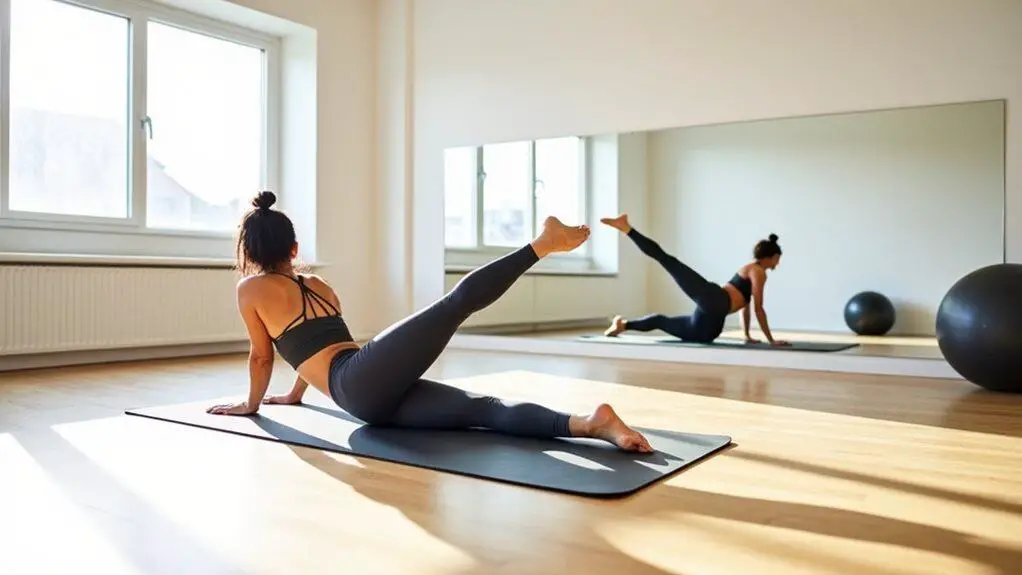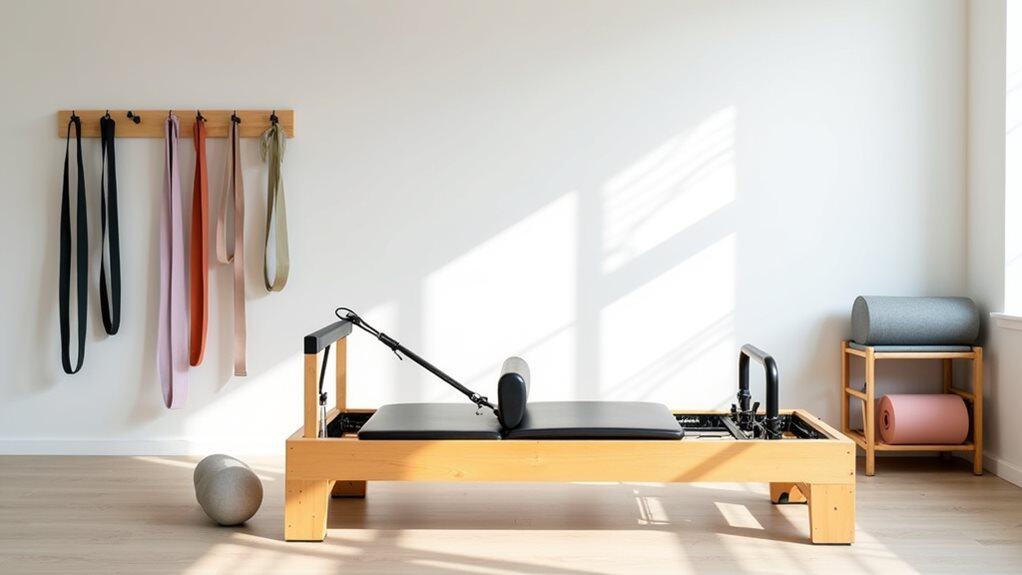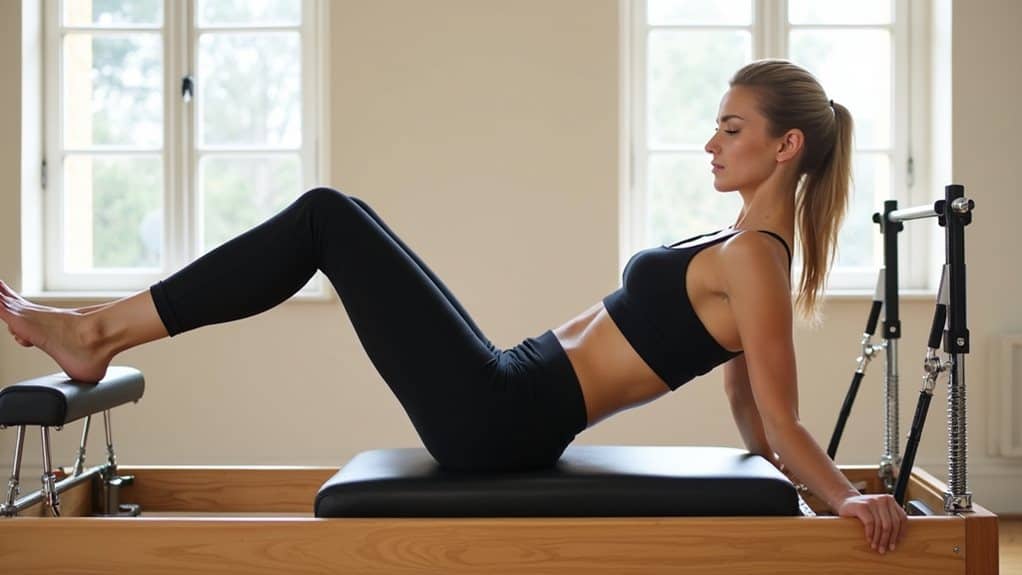Welcome to our article on the benefits of Pilates for athletes. In the athletic world, athletes often focus solely on strength and endurance training, leaving out an essential component for optimal performance – Pilates.
Pilates is a low-impact form of exercise that concentrates on improving flexibility, strength, and balance, with a focus on the mind-body connection.
This article will explore the importance of Pilates in athletic training, specifically its benefits for muscle recovery and injury prevention.
Firstly, let’s take a look at what Pilates is and how it differs from other forms of exercise.
What Is Pilates And How Does It Work?
Pilates is a form of exercise that focuses on developing core strength, flexibility, and the mind-body connection. Unlike traditional strength training, Pilates emphasizes controlled movements and proper alignment rather than heavy weights.
The philosophy behind Pilates is based on the principles of concentration, control, centering, precision, breath, and flow. By applying these principles, Pilates exercises can be executed with maximum effectiveness.
During a Pilates session, the focus is on strengthening the “powerhouse,” which includes the abdominal muscles, lower back, and buttocks. This is done through a series of exercises that target these areas and promote stability and alignment of the spine.
In addition, Pilates emphasizes the mind-body connection by using breath control and mental focus to maintain proper form and alignment. This helps to reduce stress and tension in the body and improve overall well-being.
Principles of Pilates
| Principle | Description |
|---|---|
| Concentration | Focus the mind on each exercise to ensure maximum benefit |
| Control | Perform exercises with precision and control to avoid injury and maximize effectiveness |
| Centering | Strengthen the core muscles to provide a stable foundation for movement |
| Precision | Perform exercises with precise movements to target specific muscle groups |
| Flow | Maintain smooth transitions between exercises to promote a sense of fluidity and well-being |
| Breath | Use controlled breathing techniques to promote relaxation and enhance focus |
Overall, Pilates is a safe and effective form of exercise that can improve core strength, flexibility, and overall well-being. By incorporating Pilates into your exercise routine, you can experience a wide range of benefits that will help you to lead a healthier and more active lifestyle.
Pilates Vs. Traditional Strength Training: What’s The Difference?
While both Pilates and traditional strength training can improve muscular strength and endurance, there are some key differences that set them apart.
| Pilates | Traditional Strength Training |
|---|---|
| Focus on the core muscles | Focus on specific muscle groups |
| Low-impact and gentle on joints | High-impact and can be hard on joints |
| Emphasizes proper alignment and breath | Emphasizes heavy weights and repetitions |
Pilates is unique in its emphasis on the mind-body connection and the importance of a strong core for overall health and fitness. While traditional strength training can be beneficial for building muscle mass, Pilates offers a more well-rounded approach to fitness that can improve flexibility, balance and coordination.
Another advantage of Pilates is its low-impact nature, which makes it a great option for athletes who want to avoid putting additional strain on already stressed joints and muscles. By focusing on proper alignment and breath, Pilates can also help prevent injuries and improve overall athletic performance.
Is Pilates Suitable for Everyone?
Yes, Pilates is suitable for everyone, regardless of fitness level or athletic ability. Because Pilates can be modified to suit individual needs and limitations, it is a safe and effective form of exercise for people of all ages and abilities.
- Beginners can start with basic Pilates exercises and gradually work up to more advanced movements as they gain strength and flexibility.
- Athletes can use Pilates to supplement their existing training program and prevent injuries.
- Seniors can benefit from Pilates by improving balance, flexibility and core strength.
Ultimately, whether you choose to incorporate Pilates or traditional strength training into your workout routine will depend on your personal fitness goals and preferences. However, for those looking for a low-impact, well-rounded approach to fitness, Pilates is definitely worth considering.
Pilates For Muscle Recovery: How It Helps Athletes Bounce Back Faster
Pilates is an excellent form of exercise for athletes because it can speed up muscle recovery and prevent injuries. When athletes train, they put a lot of strain on their muscles, and Pilates can help them recover more quickly. By doing Pilates exercises as part of a regular workout routine, athletes can experience faster healing times and get back to their sport faster after an injury.
Pilates can be particularly helpful for athletes recovering from sports injuries. Pilates exercises stretch and strengthen muscles, improving flexibility and range of motion. This increased flexibility can help reduce the risk of future injuries by ensuring that the body is able to move freely and without strain. In addition, Pilates can be used to target specific areas of the body that may be prone to injury, such as the knees or shoulders.
One of the keys to Pilates’ effectiveness as an injury prevention and recovery tool is its focus on core strength. By strengthening the muscles of the abdomen, back, and pelvis, Pilates can improve overall body mechanics and reduce the risk of injury. A strong core can help athletes maintain proper form and alignment during training and competition, reducing the risk of overuse injuries commonly associated with repetitive movements or poor posture.
There are many Pilates exercises that are particularly effective for muscle recovery. For example, the Pilates Bridge exercise targets the glutes and hamstrings, which can be especially beneficial for runners. Similarly, the Scissors exercise can help strengthen the hip flexors, which are often weak in athletes who focus primarily on lower body workouts. Incorporating these exercises into a regular workout routine can help athletes recover faster and avoid future injuries.
Overall, Pilates is an excellent tool for athletes looking to speed up muscle recovery and prevent injuries. By targeting specific muscles and improving overall body mechanics, Pilates can help athletes perform at their best and stay healthy and injury-free.
Pilates For Injury Prevention: How It Helps Athletes Stay On Top Of Their Game
Athletes are often at risk of injury and need to find unique ways to prevent this from happening. Pilates can be an effective tool for athletes to stay ahead of the game and avoid injury altogether. Pilates is a low-impact body conditioning exercise that helps improve strength, flexibility, and balance, which are essential components of injury prevention.
Pilates helps athletes build a strong core, which is crucial for maintaining proper alignment and balance during activities that place stress on the body. A strong core can also improve an athlete’s overall performance in their sport by providing the foundation for explosive movements.
Injury prevention is not only about building strength but also about understanding how our bodies move. Pilates focuses on the mind-body connection, which helps athletes become more aware of how their bodies move and how to move in a safe and effective way. By improving body awareness and control, Pilates can help athletes prevent injuries that may occur due to improper form or technique.
The Importance of Proper Alignment in Injury Prevention
Proper alignment is essential in preventing injuries in athletes. Pilates emphasizes proper alignment, which helps reduce the risk of injury by ensuring that the body is in the correct position when performing a movement. Pilates exercises such as the pelvic tilt, leg circles and spine stretch are particularly effective in promoting good alignment.
Improper alignment can lead to imbalances in the body, which can put unnecessary stress on certain muscles and joints, contributing to overuse injuries. Pilates helps athletes improve their alignment, reducing the risk of injury, and improving their performance in their sport.
Flexibility and Injury Prevention
Another key component of injury prevention is flexibility. Tight muscles can lead to imbalances in the body and contribute to overuse injuries. Pilates helps athletes improve their flexibility through a series of stretching exercises that focus on lengthening the muscles.
Athletes who are more flexible are less likely to sustain injuries due to muscle strain or pulls. Pilates helps athletes develop a full range of motion, which can improve their performance in their sport while reducing the risk of injury.
Pilates Complements Sport-Specific Training
Pilates can be particularly beneficial for athletes who engage in sport-specific training. It can provide a complementary form of exercise that targets different muscle groups and movements that may not be addressed in their primary training program. This can help improve overall strength, flexibility, and injury prevention.
For example, runners can benefit from incorporating Pilates exercises that improve hip mobility and core strength, which can help reduce the risk of common running injuries such as hip or IT band pain. Similarly, basketball players can benefit from Pilates exercises that target lower body strength and balance, which can improve their jumping ability and defense skills.
By incorporating Pilates into their training program, athletes can gain a competitive edge while also reducing the risk of injury, keeping them on top of their game.
Pilates For Athletic Rehabilitation: How It Can Help You Bounce Back Faster
Athletes are no strangers to injury, and rehabilitation is often a long and difficult process. Pilates can help speed up the recovery process by targeting specific muscles and movements that are essential for injury prevention and rehabilitation. Here are some ways that Pilates can benefit athletes in the rehabilitation process:
Improved Flexibility and Range of Motion
After an injury, it’s common for muscles to become tight and stiff. Pilates helps to lengthen and stretch muscles, improving flexibility and range of motion. This can help to reduce the risk of further injury and allow athletes to ease back into their regular training routine.
Increased Core Strength
The core plays a vital role in maintaining stability and protecting the body from injury. Pilates focuses on strengthening the core muscles, including the deep stabilizing muscles of the abdomen and back. Building a strong core can help to alleviate pain, improve posture, and prevent future injuries.
Improved Balance and Coordination
Many Pilates exercises are designed to challenge balance and coordination, which is essential for athletes during rehabilitation. By practicing Pilates, athletes can improve their balance and coordination, which can reduce the risk of re-injury and improve overall athletic performance.
Targeted Exercises for Specific Injuries
Pilates can be tailored to target specific muscle groups and movements that are important for athletes recovering from injuries. For example, athletes with knee injuries may benefit from exercises that focus on strengthening the quadriceps and hamstrings, while those with shoulder injuries may benefit from exercises that focus on improving shoulder stability and mobility. Pilates exercises can be modified and adapted to suit each athlete’s individual needs and recovery goals.
Low-Impact Exercise
Pilates offers a low-impact form of exercise that can be ideal for athletes during the rehabilitation process. Pilates exercises are gentle on the joints, which can help to minimize pain and discomfort during recovery. This can be particularly beneficial for older athletes or those with chronic injuries.
Overall, Pilates is a valuable tool for athletes during the rehabilitation process. By improving flexibility, core strength, balance, coordination, and targeting specific areas of the body, athletes can bounce back faster and return to their sport with greater confidence.
Pilates For Athletes: Who Can Benefit?
Any type of athlete can benefit from practicing Pilates, regardless of their sport or level of fitness. Pilates is a versatile exercise that can be modified to suit individual needs and goals. However, some sports may benefit more from Pilates as a complement to sport-specific training.
Athletes who participate in sports that require quick, explosive movements, such as basketball or soccer, can benefit from Pilates’ emphasis on core stability and controlled movements. Pilates can help improve balance and coordination, preventing injuries and enhancing performance. Similarly, endurance athletes, such as runners, can benefit from Pilates’ focus on breath and alignment, which can help improve endurance and prevent injuries from overuse.
Some athletes may also benefit from using Pilates to cross-train or recover from injuries. For example, swimmers can use Pilates to improve their overall body strength and flexibility, while gymnasts can use Pilates to develop a strong core and improve their balance and control. Additionally, athletes recovering from injuries, such as knee or shoulder injuries, can use Pilates as part of their rehabilitation program.
What Are The Benefits Of Pilates For Athletes?
The benefits of Pilates for athletes include improved core strength, flexibility, balance, and coordination. Pilates can also help prevent injuries and aid in the recovery from sports injuries. Specifically, Pilates can:
- Improve posture and alignment
- Reduce the risk of injury by strengthening muscles and joints
- Enhance athletic performance by improving balance and stability
- Improve flexibility and range of motion
- Support rehabilitation from injuries and chronic conditions
Incorporating Pilates into an athlete’s training program can help them achieve these benefits and improve their overall athletic performance.
Incorporating Pilates Into Your Athletic Training Program
If you’re an athlete looking to incorporate Pilates into your training program, the good news is that it’s easy to do. Pilates can be adapted to suit any level of fitness, so you can start at a beginner level and progress as you get stronger. Here are some tips to help you get started:
- Find the right class or instructor: Look for a Pilates class or instructor who has experience working with athletes, or one who can tailor the exercises to suit your specific athletic needs. You may also want to consider trying a private session to get personalised attention and feedback.
- Choose the right exercises: Pilates exercises can be modified to suit different levels of fitness and different athletic needs. Be sure to choose exercises that target the areas you want to work on, whether that’s core strength, flexibility or injury prevention.
- Integrate Pilates into your existing program: Pilates can be used as a complement to your existing training program, or you can use it as a standalone workout. Consider scheduling Pilates workouts on your rest days or as a warm-up or cool-down to your regular workouts.
- Modify Pilates exercises as necessary: If you have any injuries or physical limitations, be sure to modify Pilates exercises as necessary. Your Pilates instructor can help you make modifications to ensure that you’re getting the most out of your workout while staying safe.
Sample Pilates Workout for Athletes
Here’s a sample Pilates workout that’s designed specifically for athletes:
| Exercise | Reps | Sets |
|---|---|---|
| Roll-Up | 10 | 3 |
| Single Leg Circle | 10 (each leg) | 3 |
| Bridging | 10 | 3 |
| Side Plank | 30 seconds (each side) | 3 |
| Swimming | 10 | 3 |
Remember, Pilates can be adapted to suit any level of fitness, so if you’re new to Pilates or to exercise in general, start slowly and gradually build up your strength and stamina.
Pilates Equipment For Athletes: What You Need To Know
Athletes who are looking to incorporate Pilates into their training programs may be wondering what equipment is necessary to get started. While it is possible to perform many Pilates exercises using just a mat, there are a variety of Pilates-specific machines and props that can be helpful in taking your practice to the next level.
The Reformer
The reformer is perhaps the most well-known piece of Pilates equipment. It is a long, narrow machine with a sliding carriage that is attached to springs. The reformer can be used to perform a wide range of Pilates exercises, from basic lunges and squats to more advanced moves like the stomach massage series.
While the reformer can be an excellent tool for athletes looking to build strength and flexibility, it can also be quite expensive. Many Pilates studios offer reformer classes, but if you are looking to purchase a reformer for home use, be prepared to spend several thousand pounds.
Pilates Chairs
Pilates chairs are typically smaller and less expensive than reformers, but they can still be highly effective for building strength and improving flexibility. A Pilates chair consists of a small seat with two pedals attached to springs. Exercises can be performed while sitting, standing, or lying on the chair.
Pilates chairs are particularly useful for targeting the core and developing balance and coordination. They are also highly versatile, and can be used for a wide range of exercises, from simple leg presses to more complex movements like the teaser.
Other Pilates Props
In addition to the reformer and Pilates chair, there are a variety of other props that can be used to enhance your Pilates practice. Some common props include:
- Pilates balls
- Resistance bands
- Foam rollers
- Magic circles
Each of these props has its own unique benefits and can be used to target different areas of the body. For example, a Pilates ball can be used to improve balance and stability, while a foam roller can be used to release tension and improve mobility.
Safety Precautions
It is important to note that Pilates equipment should be used under the guidance of a trained instructor. Improper use of Pilates machines and props can lead to injury, so it is important to start slowly and gradually build up your practice over time.
Additionally, always make sure to check the safety of the equipment before using it. Look for any signs of wear and tear, and make sure that all springs and straps are securely attached.
With the right equipment and guidance, Pilates can be a highly effective tool for athletes looking to improve their strength, flexibility, and overall performance.
Pilates For Athletes: Frequently Asked Questions
As Pilates gains popularity among athletes, you may have some questions about this form of exercise. Here are some frequently asked questions about Pilates for athletes.
Is Pilates suitable for all sports?
Yes, Pilates is a low-impact exercise suitable for all types of athletes, regardless of the sport they play. It can help improve strength, balance, flexibility, and coordination, which are all crucial components of athletic performance.
Can Pilates help me lose weight?
Pilates is not a weight-loss program, but it can help you lose weight indirectly by improving your overall fitness level and metabolism. It can also help you develop a leaner, more toned body by building lean muscle mass and reducing body fat.
What should I wear for a Pilates class?
You should wear comfortable, form-fitting clothing that allows you to move freely. Avoid loose or bulky clothing, as it can get in the way during Pilates exercises. Most Pilates studios require participants to wear socks or bare feet.
Do I need any special equipment for Pilates?
You don’t need any equipment to do Pilates, as many exercises can be done using just your body weight. However, some Pilates classes may use props such as resistance bands, balls, or the Pilates reformer, which is a piece of equipment designed to enhance Pilates practice.
Can I do Pilates at home?
Yes, you can do Pilates at home using online tutorials or Pilates DVDs. However, it’s recommended to take some classes with a qualified instructor to get a good understanding of the correct form and techniques before doing it on your own.
How often should I do Pilates?
It’s recommended to do Pilates at least 2-3 times a week to see noticeable improvements in your strength, flexibility, and coordination. However, it’s important to listen to your body and avoid overtraining, as Pilates can be challenging on the muscles.
Can I combine Pilates with other types of exercise?
Absolutely! Pilates can be an excellent complement to other types of exercise, such as running, cycling, or weight training. It can help improve your overall fitness level and prevent injury by strengthening your core and improving your alignment.
Where can I find a Pilates class or instructor?
There are many Pilates studios and gyms that offer Pilates classes with qualified instructors. You can also find online tutorials or Pilates DVDs if you prefer to do it at home. When selecting a class or instructor, make sure they have proper qualifications and experience with working with athletes.




